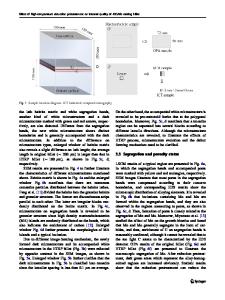A Homogeneous Billet Layer Casting Fabrication Method
- PDF / 1,434,772 Bytes
- 5 Pages / 593.972 x 792 pts Page_size
- 110 Downloads / 336 Views
Recently developed additive casting technology for the three-dimensional (3D) printing of metallic structures is widely used in parts processing due to its irreplaceable advantages[1] that include 1) near-zero material waste, 2) intricate component processing, 3) free design, and 4) homogeneous and isotropic properties. This technology has been widely used for fabricating components of various materials, such as iron-based powder[2] and aluminum alloys.[3] However, some drawbacks still exist, such as inevitable residual porosity[2] of the final components and impossible utilization on large ingots/components. On the other hand, for large ingots fabricated using conventional methods, i.e., continuous pouring (CP), various heterogeneities including the solute heterogeneity (macrosegregation) and grain size divergence[4] are inevitable due to the natural phenomena occurring such
FENGLI REN, JUNGE WANG, JUN LI, QIAODAN HU, MINGXU XIA, and JIANGUO LI are with the School of Materials Science and Engineering, Shanghai Jiao Tong University, Shanghai, 200240, P.R. China. Contact e-mail: [email protected] HONGHAO GE is with the School of Materials Science and Engineering, Shanghai Jiao Tong University and also with The University of Iowa, Iowa city, IA. HARI-BABU NADENDLA is with the Brunel University London, Uxbridge, UB8 3PH, UK. Manuscript submitted May 16, 2017.
METALLURGICAL AND MATERIALS TRANSACTIONS A
as the following: 1) solute redistribution, 2) induced melt flow, and 3) uneven local cooling rate. These heterogeneities become more severe with the increase of ingot volume or weight because the disordered melt flow becomes uncontrollable or the local cooling rate varies.[5] The uncontrollable flow may result in severe macrosegregation, and the cooling rate variation may lead to grain size heterogeneity. Many efforts have been made to study the formation mechanism of heterogeneities by experimental or modeling methods during the past decades.[6–8] For instance, Flemings first introduced hot top design to control the soundness of heavy forging ingots,[9] and experimental[10] and numerical[11] methods were later developed by other researchers. Recently, Sang et al.[12] added solid steel balls to the melt during the pouring process to reduce the macrosegregation of steel ingots. Moreover, multicomponent pouring[13] was presented in the last century, which is characterized as the sequential pouring of liquid iron with different carbon compositions to control the final macrosegregation of a large ingot. In addition, other methods such as heat treatment of liquid metal, inoculation stirring of bulk liquid, and vibrations have also been employed to modify ingot heterogeneities.[14] The solutal heterogeneity may be alleviated by these methods; however, these methods control the melt flow disorder, which is a main cause of macrosegregation, especially in large ingots. In this study, a novel additive casting approach, layer casting (LC), was proposed to achieve ingots of homogeneous properties in terms of macrosegregation and metallo
Data Loading...











